Twisted Chain Bangle crochet pattern
© June Gilbank 2013
Transform a metal or plastic bangle from cheap fashion jewellery to a stylish and unique accessory. The twisted design looks intricate but it’s a deceptively simple technique, so you can whip up an armful of bangles in next to no time. Crochet chunky bangles for a quick casual look or as perfect gifts for girls, or use finer bangles and crochet thread to make jewellery elegant enough for any occasion.

Twisted Chain Bangle is part of the PlanetJune Accessories range of crochet patterns by June Gilbank.
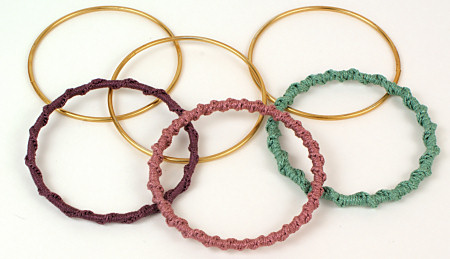
This pattern is Donationware – the pattern is available for free, but if you like it please consider sending me a donation to show your appreciation:
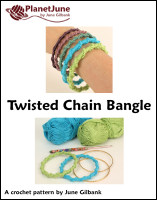
Send me a donation and receive the easy-to-print PDF version of the pattern as a thank you! It includes some additional info that you’ll only find in the PDF version:
– Additional tips and advice
– Bonus helpful photos
– Specific options for all the variations you see in my sample bangles
Donations of any size are much appreciated. Just add the amount you wish to donate, and, once you have checked out and paid, your pattern will instantly be available to download from your PlanetJune account.
The complete pattern and instructions are available below, regardless of whether or not you choose to pay for them 🙂
This is a PlanetJune original crochet pattern. Feel free to use items made from this pattern however you wish, but I’d appreciate credit as the pattern designer. Please do not reproduce the pattern anywhere else; instead post a link to www.planetjune.com/bangle
Not ready to make it yet? Add it to your Ravelry queue:
Terminology
| ch | chain |
| sc | single crochet (double crochet for UK/Aus) |
You will need…
- Inexpensive bangles (see Choosing Bangles, below)
- Crochet thread or yarn of your choice (light #3 or finer yarn recommended; size 10 or heavier thread recommended). The quantity needed will vary depending on your yarn thickness, hook size and bangle size, but you will typically need 5-10m for one bangle
Sample bangles used size 10 thread (KnitPicks Curio) and light #3 (sport weight) yarn (Patons Grace) - An appropriate hook (see the yarn’s ball band as a starting point for the hook size, but you may wish to go up or down a couple of sizes to give different results – see Gauge, below).
Sample bangles used 7 US/1.5mm, B US/2.25mm and E US/3.5mm hooks - Needle to weave in ends (as small as possible, but large enough to fit your thread/yarn through the eye – an embroidery needle is a good choice)
- Scissors
Samples
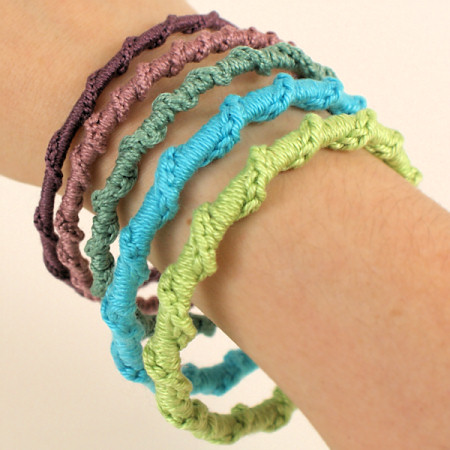
The 3 finer bangles on the left use KnitPicks Curio (size 10 thread); the two chunkier bangles on the right use Patons Grace (sport weight mercerized cotton).
Choosing Bangles
You can use this technique with any size or thickness of bangle, but I recommend a 1/4″ (6mm) or thinner bangle, unless you’re looking for a chunky result. The pictured sample bangles were between 2 and 4mm (just under and just over 1/8″) thick (before crocheting).
Give a new look to any old bangles you have lying around, or buy inexpensive fashion jewellery bangles – colour is unimportant as the bangles will be completely covered. For best value, look for a set of multiple bangles from a fashion jewellery shop, or a traditional Indian shop (where sari fabric etc is sold). You can use any smooth bangles without sharp edges; avoid textures with sharp points or uneven shapes.
Gauge
Gauge is not at all important for this pattern – the hook size will affect the look of the bangle, but there’s no right and wrong appearance! Use the hook size recommended on the ball band of your yarn as a starting point, or try experimenting with hook size by going up or down a couple of sizes to see which result you like best.
Step 1: Crocheting
Leaving a couple of inches of tail, tie the yarn around your bangle in a loose single knot (Figure 1). Holding the yarn tail along the bangle, insert your hook into the middle of the bangle (Figure 2), yarn over, and draw up a loop. Passing your hook over the top of the bangle, yarn over and ch 1. This will anchor your yarn to the bangle and give you a working loop on your hook (Figure 3).
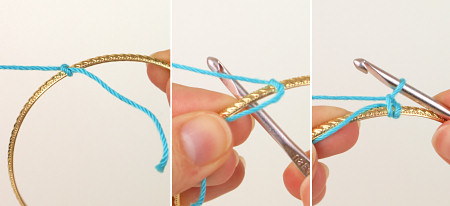
L-R: Figure 1, Figure 2, Figure 3
Begin to single crochet around the bangle and the starting tail.
Note: If you haven’t crocheted around something before, it follows exactly the same principle as working into a magic ring, except you work around the bangle instead of the ring! In other words, to make each single crochet: insert your hook under the bangle, yarn over and draw up a loop, bring your hook over the bangle, yarn over and draw through both loops on the hook.
Checkpoint A:
After crocheting a few stitches over both the bangle and the starting tail, make sure your starting knot is loose and your stitches aren’t too tight – you must be able to rotate your stitches and the starting knot easily around the bangle (Figure 4), or the next step won’t work.
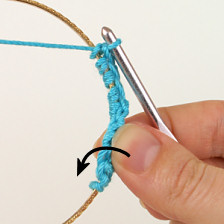
Figure 4
- If your stitches won’t slide easily over the bangle, unravel your work and start again, keeping your stitches more relaxed so there’s more wiggle room.
- If your stitches are sufficiently loose, drop the remainder of your starting tail and let it dangle, and continue to crochet around just the bangle.
Note: Do not pull the end tight or cut off the remaining tail at this stage.
Checkpoint B:
When you’re about a quarter of the way around the bangle, stop and look at your stitches. You’ll see that there are gaps between the bases of your stitches, where the bangle shows through between the wraps of yarn (Figure 5). (The size of the gaps will depend on the ratio of your hook, yarn and bangle sizes.)
Squash your stitches together so there are no gaps between the bases of your stitches (Figure 6). Don’t worry if the tops of the stitches ruffle up – it will all straighten out later!
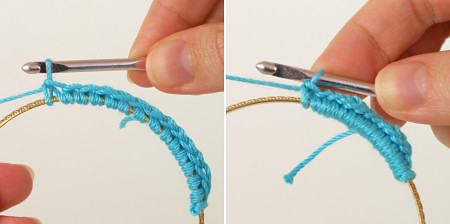
L-R: Figure 5, Figure 6
Continue crocheting around the bangle, stopping every inch or so to squash the bases of the stitches together. It’ll take a lot more stitches than you think to cover the entire bangle this way!
Checkpoint C:
When you’ve crocheted all the way around the bangle (Figure 7), pull the ends of your crocheting away from each other to expose more bangle (Figure 8) – you’ll find you can squeeze more stitches in there.
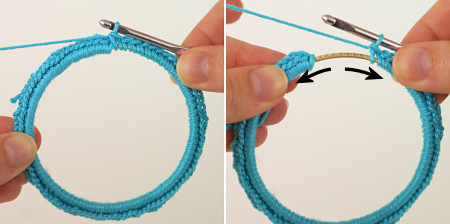
L-R: Figure 7, Figure 8
Repeat this process until you can’t cram in any more stitches without overlapping previous stitches.
Note: If you want, you can cut the working yarn now (see later for instructions) but I prefer to keep the yarn attached in case I need to squeeze in a few more stitches after Step 2!
Step 2: Twisting
Now the bangle is completely covered, but the two ends are not joined. Starting from the hook end of the bangle, keep the final stitch in place and begin to twist the next stitches, rotating them forwards into the middle of the bangle (Figure 9).
Keep the twist moving around the bangle, always rotating the stitches forward into the middle of the bangle (Figure 10). When you’ve worked the twist right through to the starting end of the yarn, go back to the other end, start another twist, and work it forward around the bangle as before. Keep going in the same way until the entire bangle is twisted.
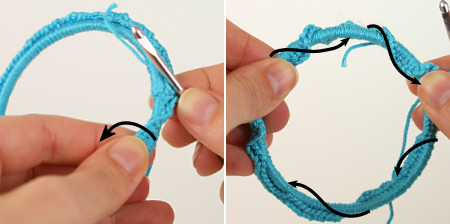
L-R: Figure 9, Figure 10
Note: You don’t have to complete one twist before starting the next – try it out and you’ll find a twisting pattern that’s easiest for you. Just remember that, eventually, the first stitch you crocheted will have to be rotated as many times as there are twists in the finished bangle – there’ll be a lot of rotations at that far end!
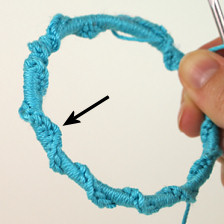
Figure 11
If your twist reverses direction halfway around the bangle (arrow, Figure 11), don’t panic! It just means you need to keep that twist moving forwards towards the starting end of the bangle, by rotating the stitches towards the middle of the bangle. It’ll even out into a neat spiral once you’ve put enough twists into the stitches.
Twisting Tips
There’s a natural angle that your stitches can twist by (the twist is limited by the length of the V shapes at the top of each stitch) but you don’t need to get technical – if you just twist gently you’ll feel a natural stopping point. You don’t need to be exact about it, and you’ll get the feel of it as you work.
If you twist past the natural stopping point, the Vs will start to be stretched and pulled in towards the bangle, and the definition of the twisted chain will be lost (Figure 12, top). Check as you rotate your stitches and make sure the twisted chain hasn’t been over-tightened.
To relax an over-tightened section, rotate the stitches in the opposite direction (outwards, away from the centre of the bangle) to loosen the twist so the chain becomes more prominent again (Figure 12, bottom).

Figure 12
Step 3: Finishing
When you’ve finished twisting, the V shapes that form the tops of the single crochets should form a continuous chain that spirals around and around the bangle. Take a good look at your bangle – this is your last chance to make sure you’re happy with it:
- If you’re not satisfied with the level of twisting in the chain, tighten the twist by adding an additional rotation, or loosen it by removing one rotation.
- If you find the bangle shows between some of your stitches, push the stitches together until they are tightly packed, and then crochet a few more stitches to fill the gap you’ve created.
When you’re happy with the look of the bangle, tweak your twists (either add a little more twist or untwist slightly) until the V shapes at either end of your crocheting meet. Cut the working yarn, leaving a few inches of tail, then draw the last loop longer until the cut end is drawn through the top of the final stitch. Thread the cut end onto a needle, then use the Invisible Finish method to join the final stitch to the first stitch.
Weave in the yarn tail, pull the remaining starting tail tight, and then snip the excess of both yarn tails as close to your stitches as possible.

I hope you enjoy this pattern. Please leave me a comment below if you do, and consider leaving me a donation. Thanks!
















Silvia said
Hello June,
Have just made 4 of your bangles. At first I did the stitches too loose, I found I had to just crotchet normally round the bangle and the stitches turned easily. Also I used yarn that was too thin.
My second trial with a much thicker yarn and a 3mm hook worked just fine.
Thank you for the very thorough instructions.
Will leave you a small donation.
Thanks again.
Silvia
Kavitha said
Hi June,
Thanks for the pattern. I loved this. This pattern is real easy and quick to learn. It does not take much time to make these. These are so cute. I did make one of these. But the twists does not stay the same when I wear it. It moves a lot when I wear it. Is there anything more that I need to do to keep the twists at place?
Thanks in advance,
Kavitha
June said
It sounds like your stitches are too loose, Kavitha, so I’d suggest you try one or more of the following, and see which help you: using a smaller hook, pulling your stitches more tightly as you form them, and/or squashing more stitches together onto the bangle. Remember, you only crochet one round of stitches for this bracelet, so you don’t need to worry that the stitches will be too small and tight to work back into, as you won’t need to do that!
Winda said
This bangle modification is so amazing!
Thank you so much for sharing your idea and effort 😀
Susan Kerin said
I have a website question as a fellow designer if you would mind contacting me personally. Could we possibly have a quick chat? thanks in advance. Susan Kerin
June said
You can email me, Susan: june@planetjune.com 🙂
Sheri * said
PS: Bangles @ any Walmart, Hobby store, even Hardware stores. I’ve used jewelry from yard sale items & thriftshops.
Sheri * said
I’ve been following you for a few years, B4 you went to Africa. (?) Kinda fun you being my eyes. I hope you don’t mind my sharing your pattern with my group. Maybe, we hope, you’ll gain more customers. Thank you for your newsletters, I enjoy them. Hugs, Sheri *
Amiguruthi said
Really pretty – I’ve got the perfect yarn for this if I can find some bangles.